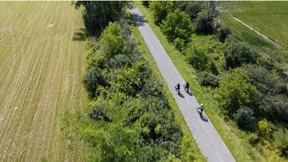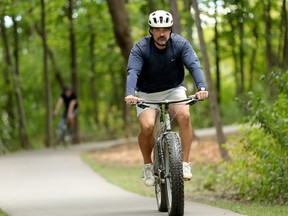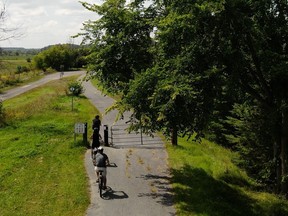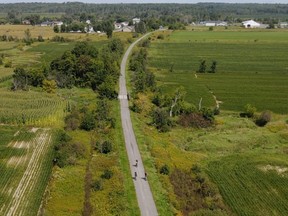The 72-km Prescott-Russell Recreational Trail is part of the 28,000-km Trans Canada trail network

Article content
A 72-kilometre trail on a former railbed that starts just east of Ottawa will be part of a cycling corridor that will connect the national capital to Montreal and a wider network of cycling trails.
The Prescott-Russell Recreational Trail stretches from Anderson Road in Ottawa’s east end to the town of Rigaud, just across the Quebec border. Most of it is level and covered in crushed stone with the exception of a few paved kilometres. Users walk and cycle the trail, or parts of it, year-round, and snowmobile, cross-country ski and snowshoe on it in the winter.
Advertisement 2
Story continues below
Article content
Last week, Destination Canada announced the launch of Cycle Ontario and Quebec for 2024, part of its “tourism corridor strategy” to connect existing cycling routes and create new ones.
This week, some of the delegates at the World Trails Conference will check out a portion of the Prescott-Russell trail. The conference will draw representatives from the trail sector from around the world, ranging from trail managers and builders to academics. The conference host is the Trans Canada Trail, which maintains Canada’s 28,000-km trail network, the world’s longest network of multi-use recreational trails.
According to counters along the Prescott-Russell trail, there were 37,000 users from the beginning of the year to September — but actual numbers are more likely twice that and the trail is drawing increasing numbers of international visitors, said Eric Collard, executive director of the Prescott-Russell trail, which is maintained by a non-profit. Developing a trail takes a build-it-and-they-will-come approach.
The rails on the Prescott-Russell trail were lifted in 1986 and the trail was launched in 2006. There are now pavilions on the trail in Hammond, Bourget, Plantagenet, Alfred, Vankleek Hill and Saint-Eugène, and a growing number of amenities accessible from the trail, ranging from pitstops, eateries and breweries to places to rent e-bikes, two campgrounds and an eco-resort. There are plans to redevelop an 1890s train station in Bourget with facilities for trail users and perhaps a museum of local history, said Collard.
Article content
Advertisement 3
Story continues below
Article content

Experienced cyclists already use the trail as a corridor between Ottawa and Montreal. But there are still a couple of “missing links,” he said. There’s a two-km portion missing between Anderson Road, where the trail starts in a field, and Ottawa’s cycling network north of Innes Road. Discussions are underway with the NCC.
On the Quebec side, there’s a 10-km missing link between Rigaud and Hudson. Once that’s established — the hopes are that it will be next year — it will link users to Quebec’s La Route vert, the longest network of cycling trails in North America.
“This is very much in the spirit of collaboration,” said Collard. “Quebec wants more of our visitors and we want more of their visitors.”
According to Velo Quebec, cycling tourism in Quebec produces $700 million in annual tourist spending, with more than 7,000 jobs related to cycling tourism.
“Cycling tourism is huge,” said Collard.

Ontario’s trails include the Great Lakes Waterfront Trail, the Bruce Trail, the Greenbelt Route and the Oak Ridges Moraine Trail. There are also other trails in Eastern Ontario that use former railbeds. The 296-km Ottawa Valley Recreational Trail stretches from near Smiths Falls almost to Mattawa, passing through Lanark County, Renfrew County and Papineau-Cameron Township.
Advertisement 4
Story continues below
Article content
“Ontario is lucky. There are a lot of old railway lines that have been decommissioned and are available to be used as recreational trails available to the public,” said Collard. “You don’t have to invest millions to turn a railbed into a trail.”
Nathalie Bercier-Gauthier owns Café Sur La Rive in a 100-year-old house that was once a convent in Plantagenet. The business started out five years ago as a café and now serves lunches and gelato, and rents e-bikes, some to local people and others to visitors who want to try out the trail.

“I never knew when I opened the café that I would be renting e-bikes,” she said. “I had no clue.”
More and more often, Bercier-Gauthier is getting repeat visitors from Montreal and Ottawa who have stopped at the café for a break while riding the trail.
“We have had more cyclists than usual from Ottawa. The word is getting around,” she said.
Bercier-Gauthier uses the trail herself, but for walks, not cycling.
“It’s a jewel. It’s something to treasure,” she said. “It has had an impact on our little town.”

Our website is your destination for up-to-the-minute news, so make sure to bookmark our homepage and sign up for our newsletters so we can keep you informed.
Recommended from Editorial
Article content


Comments